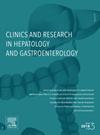经隔穿刺系统经皮肝-肝-肠新吻合术治疗儿童肝移植术后严重肝-空肠闭塞
IF 2.4
4区 医学
Q2 GASTROENTEROLOGY & HEPATOLOGY
Clinics and research in hepatology and gastroenterology
Pub Date : 2025-07-25
DOI:10.1016/j.clinre.2025.102654
引用次数: 0
摘要
小儿裂肝移植经常并发肝空肠造口狭窄,这是一个高发病率的结果,可能发展为继发性胆汁性肝硬化,如果不及时治疗,需要再次移植。经皮介入放射治疗通常是最安全和最有效的方法,以防止手术翻修狭窄的胆肠吻合术,因为内镜在Roux-en-Y通常是不可行的。我们报告的情况下,6岁儿童与左侧部分肝移植和急性发作胆汁淤积由于肝空肠吻合处闭塞。胆道狭窄是传统介入放射技术无法跨越的,因此我们成功地使用了经间隔穿刺系统来解决狭窄,通过经皮经肝入路创造了新的胆道-消化通道。在经皮经肝胆道介入手术中使用经间隔穿刺系统是不寻常的,因为这种设备通常被介入心脏病专家用于进行需要通过房间隔穿刺直接进入左心房的治疗。经皮经肝再通治疗高度闭塞性胆道狭窄是一种少见但可行且有价值的手术方法。尽管文献中报道的病例很少,但在传统方法无效的情况下,它必须被视为一种后备治疗选择。本文章由计算机程序翻译,如有差异,请以英文原文为准。
Percutaneous transhepatic bilio-enteric neoanastomosis via the transseptal puncture system in a child with split liver transplant and severe occluded hepatico-jejunostomy
Pediatric split liver transplantation can be frequently complicated with stenosis of the hepatico-jejunostomy, a high-morbidity outcome that might progress to secondary biliary cirrhosis and require re-transplantation if left untreated. Percutaneous interventional radiology management is typically the safest and most efficient way to prevent surgical revision of the stenotic bilio-enteric anastomosis because the endoscopy is typically not viable in the Roux-en-Y. We report the case of a 6-year-old child with a left lateral segment partial liver transplantation and acute onset of cholestasis due to occlusion of the hepatico-jejuno anastomosis. The biliary stricture was non-crossable with conventional interventional radiological techniques, so the transseptal puncture system was successfully used to resolve the stenosis, creating a new bilio-digestive communication via the percutaneous transhepatic approach. Employment of the transseptal puncture system for percutaneous transhepatic biliary interventional procedures is unusual because this device is commonly used by interventional cardiologists to carry out treatments that necessitate direct access to the left atrium via interatrial septal puncture. Percutaneous transhepatic recanalization of high occlusive biliary stricture is a rare but feasible and valuable procedure alternative to the surgical resolution. Despite the small number of cases reported in literature, it must be regarded as a backup therapy option in the event that the traditional methods are ineffective.
求助全文
通过发布文献求助,成功后即可免费获取论文全文。
去求助
来源期刊

Clinics and research in hepatology and gastroenterology
GASTROENTEROLOGY & HEPATOLOGY-
CiteScore
4.30
自引率
3.70%
发文量
198
审稿时长
42 days
期刊介绍:
Clinics and Research in Hepatology and Gastroenterology publishes high-quality original research papers in the field of hepatology and gastroenterology. The editors put the accent on rapid communication of new research and clinical developments and so called "hot topic" issues. Following a clear Editorial line, besides original articles and case reports, each issue features editorials, commentaries and reviews. The journal encourages research and discussion between all those involved in the specialty on an international level. All articles are peer reviewed by international experts, the articles in press are online and indexed in the international databases (Current Contents, Pubmed, Scopus, Science Direct).
Clinics and Research in Hepatology and Gastroenterology is a subscription journal (with optional open access), which allows you to publish your research without any cost to you (unless you proactively chose the open access option). Your article will be available to all researchers around the globe whose institution has a subscription to the journal.
 求助内容:
求助内容: 应助结果提醒方式:
应助结果提醒方式:


